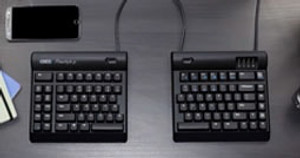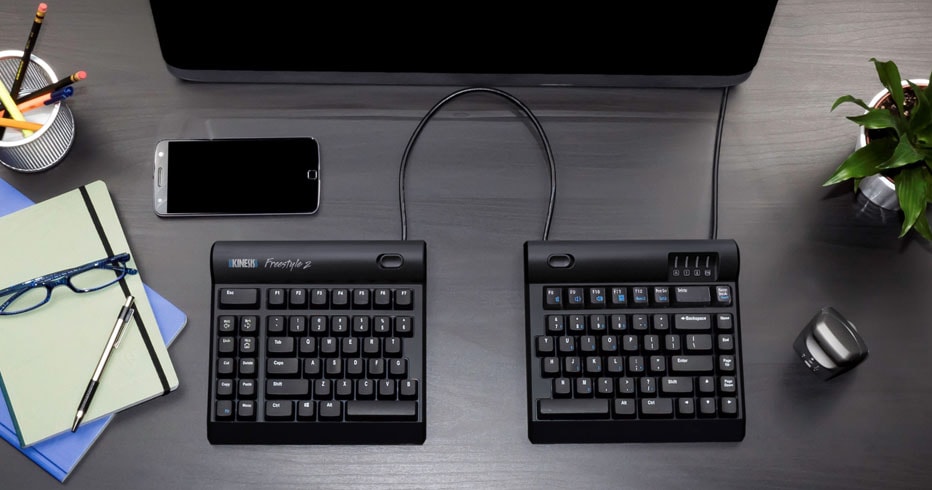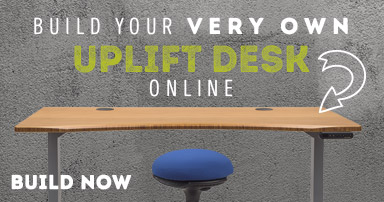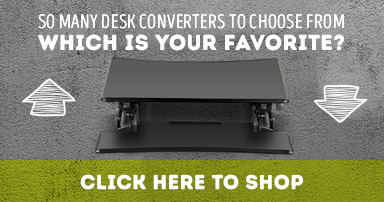Ergonomic Keyboards: Fact vs. Fiction
Posted by Mandy Spivey on Jul 27th 2018
Human Solution is a leading authority on all things ergonomic. One of our most shopped-for items, the ergonomic keyboard, gets a lot of questions. Taking the plunge and adapting your computing style to a keyboard that tents, splits, and splays might seem drastic at first, but the benefits of using an ergonomic keyboard more than makes up for the slight learning curve.
In this blog post, we're going to address some of the most common questions we've seen customers ask about ergonomic keyboards, show you how to set it up, and help you start piecing together a workspace that supports you ideally.
What Makes a Keyboard Ergonomic?
If you work in an office, chances are you know a coworker or two who work at nontraditional keyboards. Ergonomic keyboards are special workspace tools that are designed to allow the user to type comfortably and with more efficiency. It should allow the user to effectively complete their job while lessening the risk of them developing a repetitive stress injury (RSI) while typing. Basically, ergonomic keyboards are tools that fit to the user, instead of the user fitting to the board.
Depending on your body's dimensions and your personal work style, your keyboard needs might differ from your coworker's, but we're here to walk you through some of the important features to consider when shopping so you'll be sure to pick the right board for you.
Ergonomic Keyboards - Terms to Know
Tent - This is the feature that allows you to adjust the keyboard's horizontal adjustment range horizontally and vertically, from a range of 0 to 30 degrees. This allows users to type with their hands and wrists in more natural angles than traditional keyboards allow for.
Split - A feature of all ergonomic keyboards, having a keyboard that is split will give you more freedom to adjust left and right sides to the exact angle that keeps your wrists, arms, and shoulders in perfect alignment. Most keyboards give you an option of 9 or 20 inch separations.
Splay - Splaying your keyboard puts it in a "V" formation, which is ergonomically-ideal for a majority of typers.
Travel - Many ergonomic keyboards are also travel keyboards, which means they're designed to be lightweight, portable, and have fewer extra peripherals, making these boards best to use when your work is on-the-go.
Tilt Angle - This is adjustable on ergonomic keyboards and allows the user to personalize the tilt of their board.
Common Misconceptions About Ergonomic Keyboards
Ergonomic keyboards are only for those who have Carpal Tunnel or some other injury already.
This is one of the most frequent misconceptions we hear, but this one is flatly false. Users from all walks of life could work better with help from an ergonomic keyboard, even people who have never experienced pain when typing. It's never too soon to prevent stress injuries, so taking precautions early on and adopting a keyboard that adjusts to you is a wise way to ensure you don't have to stop work because of pain or strain.
It's too expensive to upgrade my office's keyboards.
A close second to the concept that only those already suffering from RSIs need keyboards that fit to them is the idea that upgrading your office's keyboards is not worth the cost. On the contrary! Investing in the ergonomic tools is a great way to save money over the long-term. This is because of the surprisingly long product life offered by most brands of ergonomic keyboards, meaning you won't have to replace them as often as basic keyboards. Not only that, but you'll save time off from work and money from saved medical expenses.
Finding the right keyboard is difficult unless you're properly trained in ergonomics.
Although finding the perfect ergonomic keyboard for your body and work style might seem obscure and difficult to do, with a minimal amount of research and comparison, most people are able to pare down the different options out there and narrow in on a keyboard that lets them type comfortably.
I only type for a few hours a day, so I don't need an ergonomic keyboard.
This sentiment is a dangerous one, because it keeps good people in bad working postures for too long. Even if you only type for 15 minutes a day, you can benefit from using a keyboard that's adjustable to you. Don't wait to implement better ergonomics at your workstation just because you aren't an "extreme typer". Give yourself the resources you need to stay happy, healthy, and comfortable with an ergo-friendly keyboard.
I don't need an ergonomic keyboard if I work with a traditional mouse.
In a majority of cases, working with an ergonomic mouse is ideal, but if you're currently working with pain, that's another story. Depending on where your pain is originating from, you might need to upgrade your mouse, as well. We can help you choose the right ergonomic mouse for you on our next blog post on the subject!
My Mac won't work with most brands of ergonomic keyboards.
Early ergonomic keyboards were not always compatible with Apple computers, but that era is over! Ergonomic keyboards for Mac are now available. No matter what your setup, you could be working better with a keyboard that puts you in control of your typing situation.
Finding the Right Ergonomic Keyboard - Follow These Three Tips for Pain-Free Typing
When you're ready to start working in comfortable keyboarding postures, there are three things you'll want to look for:
1. Adjustability - Traditional keyboards have one position, maybe two if your keyboard has legs. The most effective ergonomic keyboards allow you to adjust the angle to multiple positions, which lets many users fine-tine it to their liking.
2. Bluetooth Wireless or USB Connection - This comes down to preference for most people, but if your computer has one connection or the other, you'll need to select the right board for your peripherals.
3. Tactile Feedback of Keys - The less pressure you have to use while typing, the better it is for your wrists and hands. Try limiting the force you use for each key stroke, and shop for keyboards with keys that are not too tall and can be easily depressed.
Already Have a Keyboard? Here's How to Set Up Your New Board
After you have your ergonomic keyboard, the next step is to set it up so that it fits to your body. First, stick your fists out and in a slow and relaxed motion, then bring your elbows close to your sides in a posture that feels natural for you. Note the angles your hands are resting at - this is your correct typing angle. After you know this angle, you can set up your keyboard and lock in place.
If you're wondering how long until I get used to using an ergonomic keyboard, we hear you. After a short learning curve, you'll be on your way to typing better and with more comfort.The layout of the letters, numbers, and functions are pretty much the same as a traditional keyboard's, but some people are able to adapt to the change in hand positioning at a faster pace than others. We’ve seen users become proficient with their new keyboard in just a few days! Whatever amount of time it takes you to adjust, it should all be worth it in the end, with the increase in productivity and reduction of injury.
Okay, Now Where Do I Go From Here?
Build your ergonomic workspace, but please don't forget the crucial elements that make your workstation complete, like:
When you're ready to start working better and healthier, shop our ergonomic keyboard selection, starting with great brands like Goldtouch and Kinesis. Or, go big and start piecing together the perfect office space for you, starting with your desk. Our Desk Selector tool is a great way to learn about our desktop and frame options. Of course, if you have questions, we're here. Give us a call, chat us, or email our team and we can assist you in tailoring down your desk-buying decisions.





